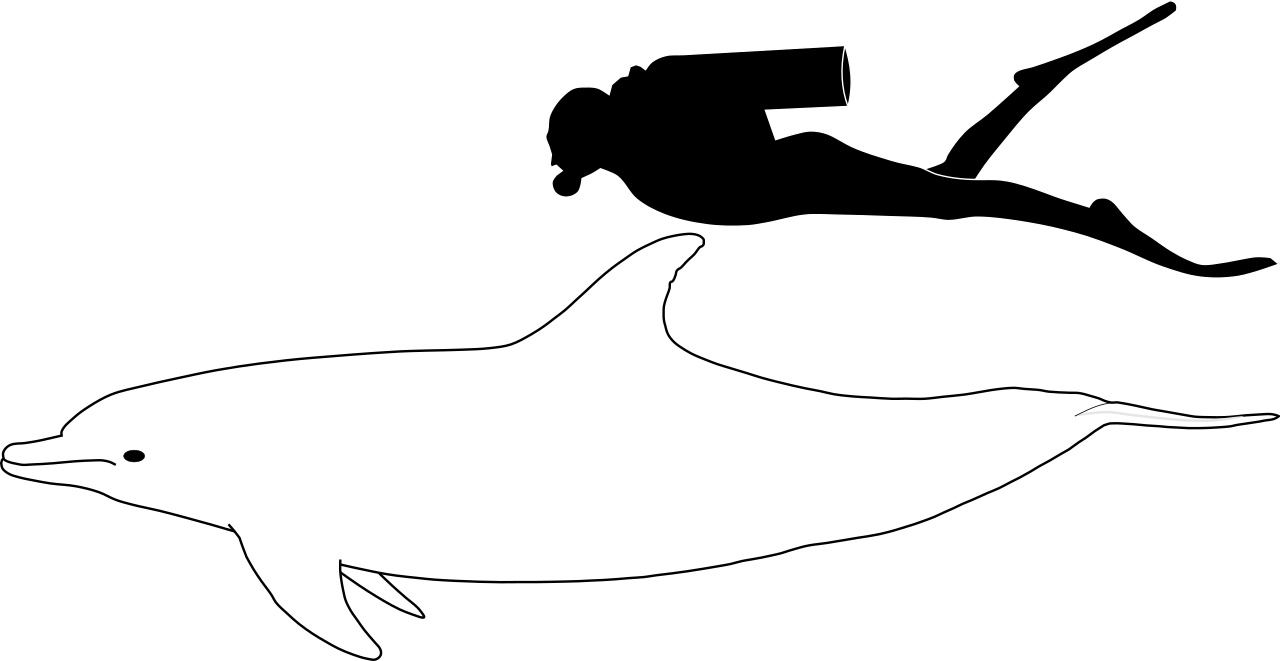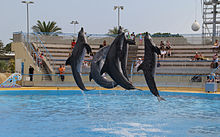Common bottlenose dolphins are the most familiar dolphins due to the wide exposure they receive in captivity in marine parks and dolphinaria, and in movies and television programs.[4] The common bottlenose dolphin is the largest species of the beaked dolphins.[5] They inhabit temperate and tropical oceans throughout the world, and are absent only from polar waters.[4][5][6][2][7] Until recently, all bottlenose dolphins were considered as a single species, but now the Indo-Pacific bottlenose dolphin[2][7] and Burrunan dolphin have been split from the common bottlenose dolphin.[3][8] While formerly named simply as the bottlenose dolphin, this term is now applied to the genus as a whole.[1][9][10] The dolphins inhabit warm and temperate seas worldwide. As considerable genetic variation has been described among members of this species, even between neighboring populations, many experts consider that additional species may be recognized.[3][9]

Description
The common bottlenose dolphin is grey in color and may be between 2 and 4 m (6.6 and 13.1 ft) long, and weighs between 150 and 650 kg (330 and 1,430 lb).[8] Males are generally larger and heavier than females. In most parts of the world, the adult's length is between 2.5 and 3.5 m (8.2 and 11.5 ft) with weight ranging between 200 and 500 kg (440 and 1,100 lb).[5][9] Newborn calves are between 0.8 and 1.4 m (2 ft 7 in and 4 ft 7 in) long and weigh between 15 and 30 kg (33 and 66 lb).[9] They can live as long as 40–50 years.[11] Sexual maturity varies by population, and ranges from 5–14 years of age.[11] Dolphins have a short and well-defined snout that looks like an old-fashioned gin bottle, which is the source for their common name.[12] Like all whales and dolphins, though, the snout is not a functional nose; the nose has instead evolved into the blowhole on the top of their heads. Their necks are more flexible than other dolphins' due to five of their seven vertebrae not being fused together as is seen in other dolphin species.[13]Behavior
K-Dog, trained by the US Navy to find mines and boobytraps underwater, leaping out of the water
Life expectancy
Common bottlenose dolphins typically live to be around 25 years old, in captivity they have been known to live to around 50.Distribution
The common bottlenose dolphin can be found in the temperate, subtropical and tropical oceans worldwide.[15] Some bottlenose populations live closer to the shore (inshore populations) and others live further out to sea (offshore populations). Generally, offshore populations are larger, darker, and have proportionally shorter fins and beaks. Offshore populations can migrate up to 4,200 km (2,600 mi) in a season, but inshore populations tend to move less. However, some inshore populations make long migrations in response to El Niño events.[9] The species has occurred as far as 50° north in eastern Pacific waters, possibly as a result of warm water events.[16] The coastal dolphins appear to adapt to warm, shallow waters. It has a smaller body and larger flippers, for maneuverability and heat dispersal. They can be found in harbors, bays, lagoons and estuaries. Offshore dolphins, however, are adapted to cooler, deeper waters. Certain qualities in its blood, suggest it is more suited to deep diving. Its considerably larger body protects it against predators and helps it retain heat.[17]Intelligence
The common bottlenose dolphin has a bigger brain than humans.[18] Numerous investigations of bottlenose dolphin intelligence include tests of mimicry, use of artificial language, object categorization, and self-recognition.[19][20][21][22][23][24] This intelligence has driven considerable interaction with humans. Common bottlenose dolphins are popular in aquarium shows and television programs such as Flipper.[25] They have also been trained for military uses such as locating sea mines or detecting and marking enemy divers, as for example in the U.S. Navy Marine Mammal Program.[26][27] In some areas, they cooperate with local fishermen by driving fish toward the fishermen and eating the fish that escape the fishermen's nets.[28]Other human interactions
This is "Biskit", a three months fetus, removed from its deceased mother during post mortem in 1993 and now on display at the Dolphin Discovery Centre in Bunbury, South West (Western Australia)
Five dolphins jumping in show.
Tião was a well-known solitary male bottlenose dolphin that was first spotted in the town of São Sebastião in Brazil around 1994 and frequently allowed humans to interact with it. The dolphin later became infamous for killing a swimmer and injuring many others, which earned it the nickname of killer dolphin.
Conservation
The North Sea, Baltic, Mediterranean and Black Sea populations of the common bottlenose dolphin are listed on Appendix II[32] of the Convention on the Conservation of Migratory Species of Wild Animals (CMS) of the Bonn Convention), since they have an unfavorable conservation status or would benefit significantly from international cooperation organized by tailored agreements.[33]The species is covered by the Agreement on Small Cetaceans of the Baltic, North East Atlantic, Irish and North Seas (ASCOBANS), the Agreement on the Conservation of Cetaceans in the Black Sea, Mediterranean Sea and Contiguous Atlantic Area (ACCOBAMS), the Memorandum of Understanding for the Conservation of Cetaceans and Their Habitats in the Pacific Islands Region,[34] and the Memorandum of Understanding Concerning the Conservation of the Manatee and Small Cetaceans of Western Africa and Macaronesia.[35]
Marine pollution

Bottle nosed dolphins are the most common apex predators found in coastal and estuarine ecosystems along the southern coast of the USA[36] , thus serve as an important indicator species of bioaccumulation and health of the ecosystem.
Dense human development along the eastern coast of Florida and intense agricultural activity have resulted in increased freshwater inputs, changes in drainage patterns, and altered water quality (i.e. chemical contamination, high nutrient input, decreased salinity, decreased sea grass habitat, and eutrophication[37] Demand for an increasing population among the Gulf Coast increases the need for oil and gas exploration and can also cause detrimental effects on the ecosystem and future population of top predators.
It is believed that some diseases commonly found in dolphins are related to human behaviors, such as water pollution. Water pollution is linked to point and non-point source pollution. Point source pollution comes from a single source such as an oil spill[38],and/or chemical discharge from a specific facility. The Environment impact of the Deepwater Horizon oil spill[39], caused a direct impact and still serves as a long term impact of future populations. Bottle nose dolphins use these important habitats for calving, foraging, and feeding. Environmental impacts or changes from chemicals or marine pollution can alter and disrupt endocrine systems, effecting future populations. For example, oil spills have been related to lung and reproductive diseases in female dolphins. A recent study,[40] suggested signs of lung disease and impaired stress in 32 dolphins that were captured and assessed in Barataria Bay, Louisiana, USA. Out of these 32 dolphins, 10 were found pregnant and upon a 47 month check up, only 20% produced feasible calves, compared to a previous success rate of 83%, in the same area. It is believed that a recent oil spill in this area, is partially to blame for these severely low numbers.
Dense human development along the eastern coast of Florida and intense agricultural activity have resulted in increased freshwater inputs, changes in drainage patterns, and altered water quality (i.e. chemical contamination, high nutrient input, decreased salinity, decreased sea grass habitat, and eutrophication[41] High nutrient input from agriculture chemicals and fertilizers causes Eutrophication[42], and hypoxia, causing a severe reductions in water quality. Excess of phosphorus and nitrogen from these non-point sources deplete the natural cycle of oxygen by overconsumption of algae. Harmful algal blooms are responsible for dead zones and unusual mortality events of bottlenose dolphins consuming these toxic fish from the brevetoxin produced by dinoflagellate, Karenia brevis. [43] Brevetoxins are neurotoxins that can cause acute respiratory and neurological symptoms including death in marine mammals, sea turtles, birds, and fishes.[44]

Common bottlenose dolphin range (in blue)



No comments:
Post a Comment
Note: Only a member of this blog may post a comment.